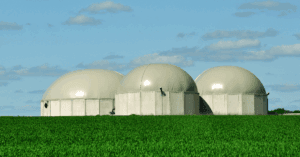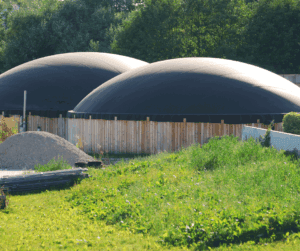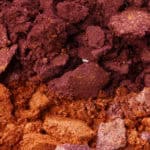Hydrogen sulfide (H₂S) is a gas that forms naturally during the anaerobic digestion of organic matter. In biogas plants, this compound represents one of the greatest technical challenges due to its high toxicity, corrosiveness, and its negative impact on both equipment and safety.
What is hydrogen sulfide?
Hydrogen sulfide is a colorless gas with a characteristic “rotten egg” odor. It is primarily generated through the decomposition of sulfur-rich organic matter in oxygen-free environments—a common condition in anaerobic digesters used for biogas production.
Key properties of H₂S:
- Chemical formula: H₂S
- Density: Heavier than air
- Solubility: Moderately soluble in water
- Toxicity: Highly toxic at moderate to high concentrations
Why is H₂S a problem in biogas?
1. Equipment corrosion
H₂S reacts with water vapor to form hydrosulfuric acid, which is extremely corrosive to metals like steel and copper. This leads to degradation in:
- CHP engines
- Gas turbines
- Heat exchangers
- Piping systems
2. Health risks
Even at low concentrations, prolonged exposure to hydrogen sulfide can cause:
- Eye and respiratory irritation
- Dizziness, fatigue, and nausea
- At high levels, it can be fatal
3. Environmental concerns
If biogas containing H₂S is released or burned improperly, it can result in harmful emissions, contributing to acid rain and poor air quality.
Common methods for removing H₂S from biogas
The process of removing hydrogen sulfide is known as biogas desulfurization, and it can be achieved through various methods:
Biological desulfurization
Uses bacteria to convert H₂S into elemental sulfur. Effective, but requires careful monitoring and control.
Chemical scrubbing
Biogas is passed through alkaline solutions that absorb H₂S. While efficient, it produces liquid waste that must be treated.
Solid-phase adsorption
This is where iron-based compounds—such as iron hydroxide—play a key role by reacting directly with H₂S and binding it safely.
MICRONOX BIOX ON16: a natural and effective solution
PROMINDSA has developed MICRONOX BIOX ON16, a natural product based on iron hydroxide, specifically designed for the chemical adsorption of hydrogen sulfide in biogas purification.
Main benefits:
- High H₂S retention capacity
- Adaptable to various plant configurations
- Natural, safe, and easy to handle
- Supports a circular and sustainable economy
Frequently asked questions (FAQs)
What are acceptable H₂S levels in biogas?
It depends on the application. For engines, levels below 200 ppm are usually required. More sensitive systems demand even lower levels (<10 ppm).
Is H₂S easy to detect?
Yes. Although it has a strong odor at low concentrations, it can numb the sense of smell at high levels, so specific gas sensors are recommended.
Can iron hydroxide be regenerated?
In some cases, yes. Once saturated, it can be thermally reactivated or used as a sulfur-rich soil amendment, depending on local regulations.
Is MICRONOX BIOX ON16 suitable for any plant?
Absolutely. Its granular form, non-toxic nature, and efficiency make it ideal for both small-scale setups and large industrial biogas plants.








